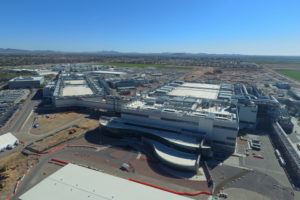
EDACafe Editorial Roberto Frazzoli
Roberto Frazzoli is a contributing editor to EDACafe. His interests as a technology journalist focus on the semiconductor ecosystem in all its aspects. Roberto started covering electronics in 1987. His weekly contribution to EDACafe started in early 2019. Intel announces two new U.S. fabs and launches its own foundry businessMarch 25th, 2021 by Roberto Frazzoli
Just a couple of months after taking office, Intel’s new CEO Pat Gelsinger delivered on the expectations of a quick strategy change – and his plan caught many observers by surprise. Investors who had suggested Intel to embrace the fabless model will probably be disappointed, as Gelsinger – speaking at a webcast event on March 23 – announced just the opposite: not only will Intel increase its manufacturing capability, but it will also create a foundry business on its own. Gelsinger’s bold move resonates very well with the current climate characterized by geopolitical tensions, incentives from the Biden administration, and a severe chip shortage. However, turning his plan into reality might prove to be difficult, according to some observers. A renewed technological self-confidence One of the key elements of Intel’s new course is a renewed confidence in its internal technological capabilities. The company expects to continue manufacturing the majority of its products internally, and – as stated in a press release – the 7nm development is progressing well, driven by increased use of extreme ultraviolet lithography. Intel expects to tape out the compute tile for its first 7nm client CPU (code-named “Meteor Lake”) in the second quarter of this year. During the webcast, Intel officers reportedly did not directly address the issue of catching up with the leading foundries – as far as the 5nm and 3nm nodes are concerned. However, Gelsinger reportedly offered an explanation for Intel’s delay in moving to the most advanced process nodes: he said the company was too cautious about EUV lithography equipment and, to compensate, the designs got excessively complicated, leading to production problems. Gelsinger also announced a new research collaboration with IBM focused on creating next-generation logic and packaging technologies, which should clearly help Intel to catch up quickly. The internal capabilities on which the company is relying to fuel its new course include its expertise in advanced packaging technologies for chiplet-based devices.
Third-party foundries are still part of the equation A second element in the new strategy announced by Gelsinger is an expanded use of third-party foundry capacity. He expects Intel’s engagement with third-party foundries to grow and to include manufacturing for a range of modular tiles (chiplets) on advanced process technologies, including products at the core of Intel’s computing offerings for both client and data center segments beginning in 2023. According to the company, this will ultimately give Intel “a unique competitive advantage.” The establishment of Intel Foundry Services Probably the most unexpected part of the announcement is the one concerning the establishment of a new standalone business unit, Intel Foundry Services (IFS), led by semiconductor industry veteran Dr. Randhir Thakur, who will report directly to Gelsinger. IFS will offer “committed capacity” in the U.S. and Europe, and an IP portfolio including x86 cores as well as ARM and RISC-V ecosystem IPs. The foundry business – which will be an independent organization with full profit&loss responsibilities – is “ready to engage with customers today on existing foundry offerings.” Intel points out that IFS is preparing whatever it takes to be a real foundry: collaborations to advance design and IP capabilities, investments in developing industry standard PDK models, simplified design rules, expanded EDA partnerships and foundational IP offerings – complete with standard interfaces – as well as third-party IP availability. The IFS announcement includes supporting quotes from Amazon Web Services, Cisco, Ericsson, Google and Alphabet, IBM, Microsoft, Qualcomm. Two new Intel fabs in Arizona – and more being planned in Europe Gelsinger also announced an expansion of Intel’s manufacturing capacity, beginning with plans for two new fabs in Arizona located at the company’s Ocotillo campus – near Chandler. These fabs, which represent an investment of approximately $20 billion, will support both Intel’s current products and customers and the future IFS foundry customers. Construction of the planned factories is expected to begin immediately. With the addition of these two new fabs, the Arizona site will become Intel’s largest manufacturing site in the world; the campus covers approximately 700 acres. The Intel statement announcing this investment includes supporting quotes from U.S. Secretary of Commerce, the Governor of Arizona, members of the U.S. Congress and other authorities. Gelsinger said he plans to announce the next phase of capacity expansions in the U.S., Europe and other global locations within the year. From Intel Developer Forum to “Intel On” Part of the announcement concerned a renewed version of the Intel Developer Forum, which will be renamed “Intel On”. The first edition of the hybrid (physical/digital) event is planned for next October in San Francisco. Goal of the initiative is “bringing back the spirit of the beloved IDF series while adding new refinements and evolutions.” Comments from the media Needless to say, the new Intel strategy has been widely covered and commented by the media. Some observers note that Intel has tried to offer foundry services before, with no success; on this point, Gelsinger reportedly replied that that first attempt was “half-hearted”. Observers also point out the intricacies of the new situation, with Intel being at the same time a customer and a competitor for some third-party foundries, or a supplier and a competitor in the case of the relationships between its new foundry business and other IDMs. One aspect considered as a sharp departure from the past is the fact that Intel is now ready to offer the x86 architecture as an IP block to its future foundry customers. Another commentator expect the foundry business to drag down the company’s average profit margins. With Intel planning to put his plans into action soon, we should be able to see the first market reactions shortly. Upcoming industry events Let’s now move to a different chapter, our usual reminder of upcoming industry events. Running from March 29 to April 1 as a virtual event, GOMACTech focuses on advances in systems being developed by the U.S. Department of Defense and other U.S. government agencies. Established in 1968, the conference has been used to announce major government microelectronics initiatives such as VHSIC and MIMIC, and provides a forum for government reviews. The GOMACTech Conference is an Unclassified, Export-Controlled event that requires participants to be U.S. Citizens or legal U.S. Permanent Residents. The Linley Spring Processor Conference will take place as a virtual event from April 19 to 23. This year will be Linley’s biggest Spring Conference program yet – with five days of technical presentations, new product disclosures, and panel discussions covering a broad range of topics. The program will feature live-streamed presentations addressing processors and IP cores for AI applications, embedded, data center, automotive, and IoT designs. |
|
|
|||||
|
|
|||||
|
|||||








